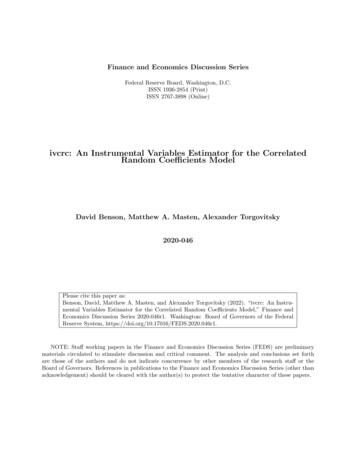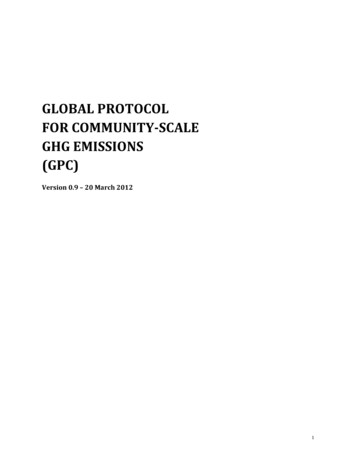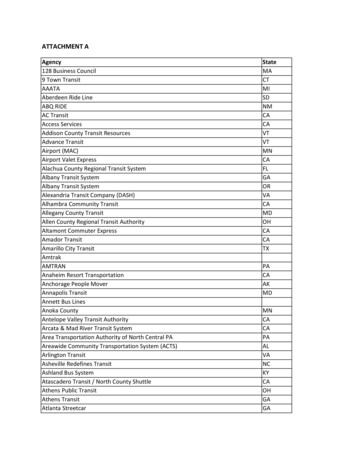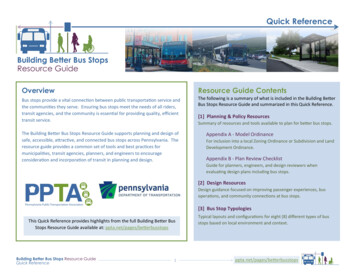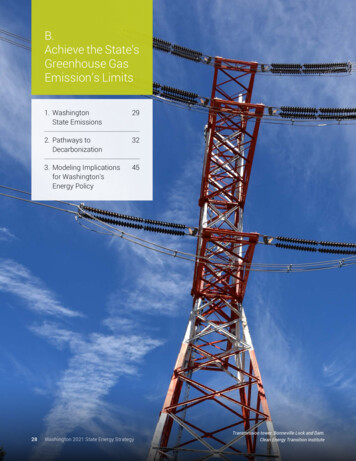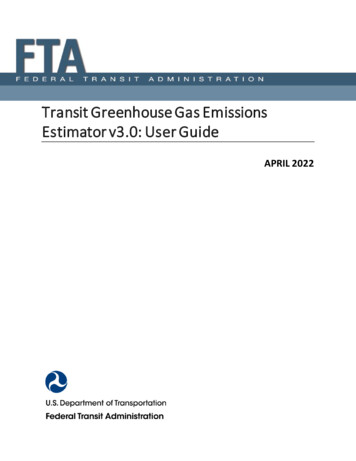
Transcription
Transit Greenhouse Gas EmissionsEstimator v3.0: User GuideAPRIL 2022
NoticeThis document is disseminated under the sponsorship of the Department of Transportation in theinterest of information exchange. The United States Government assumes no liability for thecontents or use thereof.The United States Government does not endorse products or manufacturers. Trade ormanufacturers’ names appear herein solely because they are considered essential to theobjective of this report.
REPORT DOCUMENTATION PAGEForm ApprovedOMB No. 0704-0188Public reporting burden for this collection of information is estimated to average 1 hour per response, including the time for reviewing instructions, searching existing data sources,gathering and maintaining the data needed, and completing and reviewing the collection of information. Send comments regarding this burden estimate or any other aspect of thiscollection of information, including suggestions for reducing this burden, to Washington Headquarters Services, Directorate for Information Operations and Reports, 1215 JeffersonDavis Highway, Suite 1204, Arlington, VA 22202-4302, and to the Office of Management and Budget, Paperwork Reduction Project (0704-0188), Washington, DC 20503.1. AGENCY USE ONLY (Leave blank)2. REPORT DATE3. REPORT TYPE AND DATES COVEREDApril 2022User Guide4. TITLE AND SUBTITLE5a. FUNDING NUMBERSTransit Greenhouse Gas Emissions Estimator v3.0 User Guide69319519N2000246. AUTHOR(S)5b. CONTRACT NUMBERGina Filosa and Carson Poe8. PERFORMING ORGANIZATIONREPORT NUMBER7. PERFORMING ORGANIZATION NAME(S) AND ADDRESS(ES)U.S. Department of TransportationJohn A Volpe National Transportation Systems Center55 BroadwayCambridge, MA 02142-1093DOT-VNTSC-FTA-22-039. SPONSORING/MONITORING AGENCY NAME(S) AND ADDRESS(ES)10. SPONSORING/MONITORINGAGENCY REPORT NUMBERUS Department of TransportationFederal Transit AdministrationOffice of Environmental Programs1200 New Jersey Avenue, SEWashington, DC 2059011. SUPPLEMENTARY NOTESProject Manager: Saadat Khan12a. DISTRIBUTION/AVAILABILITY STATEMENT12b. DISTRIBUTION CODEThis document is available to the public on the FTA website 3. ABSTRACT (Maximum 200 words)The Transit Greenhouse Gas (GHG) Emissions Estimator (Estimator) is a Microsoft Excel-based spreadsheet tool that allows users to estimate thepartial lifecycle GHG emissions generated and energy used during the construction, operation, and maintenance phases of a project across selecttransit modes. Users input general information about a project, and the Estimator calculates annual GHG emissions by project phase. Although theEstimator lacks the precision for projections that may be attainable by using more complex emission models or route-specific ridership estimates, itcan generate early, informative GHG emissions and energy use estimates for a broad range of transit projects.14. SUBJECT TERMS15. NUMBER OF PAGESGreenhouse gas emissions, transit, National Environmental Policy Act2416. PRICE CODE17. SECURITY CLASSIFICATIONOF REPORTUnclassifiedNSN 7540-01-280-550018. SECURITY CLASSIFICATIONOF THIS PAGEUnclassified19. SECURITY CLASSIFICATIONOF ABSTRACT20. LIMITATION OF ABSTRACTUnlimitedUnclassifiedStandard Form 298 (Rev. 2-89)Prescribed by ANSI Std. 239-18298-10
CONTENTS1Introduction. 12Getting Started. 43How to Use the Estimator . 5Step 1: Select the location (state) . 5Step 2: Enter analysis period (years). 5Step 3: Enter Construction Inputs . 5Step 4: Enter Facility Operations Inputs . 6Step 5: Enter Transit Vehicle Operations and Maintenance Inputs . 8Step 6: Enter Displaced Emissions Inputs . 9Step 7: View Results .104Data Sources and Data Limitations .12Construction Related Emission Factors .12Maintenance Related Emission Factors.13Vehicle Operations Related Emission Factors.13Facility Operations Related Emission Factors .14Carbon Storage Emission Factors .15APPENDIX A: Emissions Factors Used in the Estimator.16APPENDIX B. Transit Mode Definitions .24FIGURESFigure 1: Construction Inputs Screen . 5Figure 2: Facility Operations Inputs Screen . 7Figure 3: Transit Vehicle Operations & Maintenance Inputs Screen . 8Figure 4: Displaced Emissions Input Screen. 9Figure 5: Results Screen .11Figure 6: eGRID Subregions .14TABLESTable 1: GHG Emission Sources By Phase and Transit Mode . 2Table 2: Heavy Rail Factors .16Table 3: Commuter Rail Factors .17Table 4: Light Rail and Streetcar Factors .18Table 5: Bus/Brt Factors .19Table 6: Vanpool Factors.19Table 7: School Bus Factors .19i
Table 8: Demand Response Bus Factors.20Table 9: Sedan / Automobile Factors .20Table 10: Parking Factors .20Table 11: Carbon Storage GHG Emission Factors.20Table 12: State-Specific GHG Emission Factors for Downstream, Underground Track Mile Constructionfor Heavy Rail, Commuter Rail, and Light Rail/Streetcar.21Table 13: Region-Specific Upstream Emission Factors for Operation Of Electric Heavy Rail, CommuterRail, and Light Rail/Streetcars .22Table 14: Region-Specific Upstream Emission Factors for Operation Of Electric Bus, Sedan/Auto, andPhev-Gas Vehicles.23ii
1 IntroductionThe Transit Greenhouse Gas (GHG) Emissions Estimator (Estimator) is a Microsoft Excel-basedspreadsheet tool that allows users to estimate the partial lifecycle GHG emissions generated and energyused in the construction, operation, and maintenance phases of a project across select transit modes.Users input general information about a project, and the Estimator calculates annual GHG emissions andenergy use by project phase (Table 1). Total annual GHG emissions for a transit project is the sum ofamortized construction emissions, annual maintenance emissions, and annual operations emissions,minus annual displaced emissions.The National Environmental Policy Act (NEPA) requires federal agencies to disclose and analyze theenvironmental effects of their proposed actions. The Federal Transit Administration (FTA) developed theoriginal version of the Estimator in connection with its Greenhouse Gas Emissions from Transit ProjectsProgrammatic Assessment (2016) as a tool for agencies to generate project-specific GHG emissionsestimates for their NEPA analysis. Although the Estimator lacks the precision for projections that may beattainable by using more complex emission models or route-specific ridership estimates, it can generateearly, informative GHG emissions estimates for a broad range of transit projects. In no case is the use ofthis tool mandatory, and transit agencies should work with FTA Regions to determine whether toconduct project-specific analyses of GHG emissions and the best approach for doing so.In 2022, the FTA updated the Estimator as follows: Added functionality to generate estimates of lifecycle energy use in the construction, operation,and maintenance phases of a transit project Added “100% renewable energy” as an electricity source Removed gas-powered bus/BRT as a vehicle choice 1 Updated GHG emission factorsAgencies that seek to estimate the partial lifecycle GHG emission savings associated with replacingstandard bus fleets with low-emission or zero-emission transit buses should use the Transit BusElectrification Tool available at G emissions factors for buses are from Argonne National Laboratory’s Greenhouse Gases, RegulatedEmissions, and Energy use in Transportation (GREET) Model. The most recent version, the 2021 model, no longerincludes data for gasoline powered buses.11
TA BL E 1 : GHG EM ISSION SOURC ES BY P HASE A ND TRA NSIT M ODEPhaseModeRailConstructionBus/Bus Rapid Transit d Response BusVehicle OperationSchool busVanpoolSedan/autoRailFacility OperationBus/BRTCarbon StorageN/AGHG Emission and Energy Sources IncludedNew, at-grade track mileNew, elevated track mileNew, underground track mileConverted or upgraded existing track mile (light rail only)New, at-grade rail stationNew, elevated rail stationNew, underground rail stationRail catenary system (GHG emissions only)New lane or right-of-way mileConverted or upgraded lane mileNew, at-grade stationBus/BRT catenary systemSurface parkingStructured (garage) parkingRail transit vehicle (GHG emissions only)TrackPavementElectric vehicleDiesel vehicle (commuter rail only)Electric vehicleDiesel vehicleHybrid diesel vehicleCompressed Natural Gas (CNG) vehicleElectric vehicleDiesel vehicleHybrid diesel vehicleCNG vehicleGas vehicleDiesel vehicleCNG vehicleDiesel vehicleGas vehicleGas vehicleDiesel vehicleAll electric vehiclePlug-in hybrid electric vehicleHybrid electric vehicleStation electricityStation heatingMaintenance/storage electricityMaintenance/storage heatStation electricityStation heatingMaintenance/storage electricityMaintenance/storage heatChange in carbon storage due to tree cover changes2
Using the Estimator involves the following basic steps: Select the location (state) of your project Select the analysis period (years) Enter construction inputs Enter facility operation inputs Enter vehicle operations and maintenance inputs Enter displaced emissions inputs Calculate and review resultsSection 3 provides detailed instructions for each step. Section 4 provides information on the Estimator’sdata sources and assumptions. The emission factors used in the Estimator are listed in Appendix A.3
2 Getting StartedWhen opening the tool for the first time a user will need to enable macros. If an “Enable Content”Security Warning appears, click the “Enable Content” button. If the Security Warning does not appearwhen the tool is first opened, it may be necessary to change the security settings for macros. To changethe setting, first exit out of the tool and re-launch Microsoft Excel before opening the Estimator Tool.Next, click on the Microsoft Excel icon or File menu in the top left of the screen. Scroll to the bottom ofthe menu and select the “Excel Options” button to the right of the main menu. When the Excel Optionsbox appears, select “Trust Center” in left hand menu of the box. Next, click the gray “Trust CenterSettings” button. When the Trust Center options box appears, click “Macro Settings” in the left-handmenu and select “Disable all macros with notification.” Once the security level has been adjusted, openthe tool and enable macros as described above.4
3 How to Use the EstimatorStep 1: Select the location (state)On the GHG Calculator tab, choose the state the project is located in from the drop-down menu. Someof the emission factors used in the tool vary based on the location of the project (see Appendix A).Step 2: Enter analysis period (years)On the GHG Calculator tab, enter the analysis period in years. The analysis period is the timespan overwhich a user wishes to assess impacts. The information will be used to amortize the construction-relatedGHG emissions for the project’s annualized emissions, as well as to scale up operations, maintenance,and displaced emissions calculations for the project’s total cumulative emissions. As an example, if auser chooses 20 years as the analysis period, construction emissions will be divided to return annualconstruction-related emission estimates over each of 20 years, and operations, maintenance, andemissions displaced will be multiplied over the analysis period to generate the total emissions result.Users will then enter project information related to construction, facility operations, vehicle operationsand maintenance, and displaced emissions. Users can navigate to each of the different data inputscreens using the buttons on the “GHG Calculator” tab, or by clicking on the individual tabs.Step 3: Enter Construction InputsThe annual GHG emissions from a transit project include emissions associated with new track miles, lanemiles, transit stations, and/or structure (garage) and surface parking constructed as part of the project,as well as the annual, changes in carbon storage/sequestration 2 due to changes in tree cover.The tool asks users to enter information associated with constructing a transit project (Figure 1). If thisinformation is not applicable to the project, click the “Return to Calculator” link at the top right-handcorner of the screen or the “Facility Operations” tab to proceed to the next data input screen.FIGURE 1 : C ONSTRUC TION INP UTS SC REEN2Carbon sequestration describes the process by which carbon is removed from the atmosphere and stored in carbon sinks suchas oceans, forests, or soils.5
On the Construction tab enter the following information: Structured Parking Spots: Enter the total number of structured (garage) parking spaces that areplanned to be constructed for the project. Surface Parking Lot Spots: Enter the total number of surface parking lot spaces that are plannedto be constructed for the project. Trees removed: Enter the total number of trees that are planned to be removed due toconstructing the transit project. If there will be a net gain in trees, enter the number as anegative (e.g., if a net gain of five trees is anticipated, enter -5). Select Transit Mode: From the pull-down menu, select the type of transit mode beingconstructed (see Appendix B for transit mode definitions).o Heavy Railo Commuter Railo Light Rail or Streetcaro Bus/Bus Rapid Transit (BRT)For each transit mode enter the following: Miles of new track/lane miles by alignment type: Enter the number of new miles of track (orlane-miles for BRT projects) that are planned to be constructed. Enter number of miles byalignment: above ground, below ground, or at-grade. Miles of converted or upgraded track/alignment (light rail, streetcar, and BRT only): Forconstruction that involves converting or upgrading an existing facility, enter the number of milesof converted or upgraded track (for light rail or streetcar projects) or lane-miles (for BRTprojects). Miles of catenary: Enter the number of miles of catenary overhead wire that are planned to beconstructed for the project. If the project does not use a catenary system, leave the cell blank orenter zero. Number of new stations by alignment types: Enter the number of stations that are planned tobe constructed for the project. Enter number of stations by type: above ground, below ground,or at-grade. Continue to add transit construction inputs as needed to account for all transit modesassociated with the project. Once all construction related inputs associated with the transit project have been added clickthe “Return to Calculator” link at the top of the page to return to the summary/results page orselect the “Facility Maintenance” tab to move to the next data input screen.Note: The information entered on the construction page is used to generate the GHG emissions andenergy use associated with maintaining the transitway.Step 4: Enter Facility Operations InputsThe annual GHG emissions from a transit project include emissions associated with the operations ofnew maintenance/storage facilities and/or transit stations constructed as part of the project. The toolasks user to enter information associated with new facilities constructed as part of the new transit6
project (Figure 2). If this information is not applicable to the project, click the “Return to Calculator” linkat the top right-hand corner of the screen or the “Vehicle Operations” tab to proceed to the next datainput screen.FIGURE 2 : FA C ILITY OP ERATIONS INP UTS SC REENOn the Facility Operations tab input the following information: Select a Mode: From the pull-down menu, select the transit mode that the facility is associatedwith:o Heavy Railo Commuter Railo Light Rail or Streetcaro Bus/Bus Rapid Transit Select Building Type: From the pull-down menu, select the type of facility that will beconstructed as part of the transit project:o Stationo Maintenance/Storage Facility Enter Size of Facility: Enter the size (in square footage) of the new facility to be constructed aspart of the new transit project. Note: Enter the square footage for the building itself, and notthe overall property. Continue to add facility operations inputs as needed to account for all new facilities constructedas part of the transit project.7
Once all facility operations related inputs associated with the transit project have been addedclick the “Return to Calculator” link at the top of the page to return to the summary/results pageor select the “Vehicle Operations & Maintenance” tab to move to the next data input screen.Step 5: Enter Transit Vehicle Operations and Maintenance InputsThe annual GHG emissions and energy use from a transit project include emissions associated with theoperations and maintenance of rail- and road-based transit vehicles.The tool asks user to enter information associated with vehicle operations of the new transit project(Figure 3). If this information is not applicable to the project, click the “Return to Calculator” link at thetop right-hand corner of the screen or the “Displaced Emissions” tab to proceed to the next data inputscreen.FIGURE 3 : TRA NSIT V EHIC LE OP ERA TIONS & M AINTENA NCE INP UTS SC REENOn the Vehicle Operations tab input the following information: Select a Transit Mode: From the pull-down menu, select the type of transit mode that willoperate as part of the transit projecto Heavy Railo Light Rail or Streetcaro Commuter Railo Bus/Bus Rapid Transito Vanpoolo School buso Demand Response (DR) Buso Sedan/Auto Select Fuel Source: From the drop-down menu, select the type of fuel that the transit vehiclewill use to operate. Notes regarding fuel source:o Heavy rail, light rail, and streetcar have electric as the only fuel source option.8
o The tool does not include all possible vehicle fuels for buses, demand response vehicles,and vanpools. For example, buses fueled by liquefied propane gas, ethanol, kerosene,and hydrogen are not included in the tool because either the data for the emissionsassociated with these fuel types were not readily available or the size of the existingfleet of these vehicles is significantly smaller than that of those buses included in theEstimator. Select eGRID Subregion: For electric fuel sources, users will need to select an eGRID subregionfrom the corresponding drop-down menu. The tool allows the user to choose:o The “US Mix”, which represents the average electricity generation mix for the country,o An eGRID subregion, which reflects more region-specific electricity generation. Refer tothe map of eGRID subregions to identify the applicable subregion or refer to the eGRIDPower Profiler tool to look up the subregion by zip code.o 100%-renewable energy, which should be used in cases where the electricity used tocharge the vehicle is entirely from renewable energy sources. Enter Annual Transit Vehicle Miles Traveled (VMT): Enter in the annual VMT for the selectedtransit mode. Continue to add transit operation inputs as needed to account for all transit operationsassociated with the transit project. Once all transit operations related inputs associated with the transit project have been added,click the “Return to Calculator” link at the top of the page to return to the summary/resultspage, or select the “Displaced Emissions” tab to move to the next data input screen.Step 6: Enter Displaced Emissions InputsThe annual GHG emissions from a transit project includes vehicle emissions displaced by the new transitproject.The tool asks users to enter information associated with transit and personal vehicle VMT that a userexpects the new transit project to displace (Figure 4). If this information is not applicable to the project,click the “Return to Calculator” link at the top right-hand corner of the screen.FIGURE 4 : DISP L AC ED EM ISSIONS INPUT SC REEN9
On the Displaced Emissions, tab input the following information: Select a Mode: From the pull-down menu, select the type of mode that will have VMT displaceddue to the transit project:o Heavy Railo Light Rail or Streetcaro Commuter Railo Bus/Bus Rapid Transito Vanpoolo School buso Demand Response (DR) Buso Sedan/Auto Select Fuel Source: From the drop-down menu, select the type of fuel that the vehicle isexpected to use to operate. Notes regarding fuel source:o Heavy rail, light rail, and streetcar have electric as the only fuel source option.o The tool does not include all vehicle fuels for buses, demand response vehicles, andvanpools. For example, buses fueled by liquefied propane gas, ethanol, kerosene, andhydrogen are not included in the tool because either the data for the emissionsassociated with these fuel types were not readily available or the size of the existingfleet of these vehicles is significantly smaller than that of those buses included in theEstimator. Select eGrid Subregion: For electric fuel source, users will also need to select an eGRIDsubregion from the corresponding drop-down menu. The tool allows the user to choose:o The “US Mix”, which represents the average electricity generation mix for the country,o An eGRID subregion, which reflects more region-specific electricity generation. Refer tothe map of eGRID subregions to identify the applicable subregion or refer to the eGRIDPower Profiler tool to look up the subregion by zip code.o 100%-renewable energy, which should be used in cases where the electricity used tocharge the vehicle is entirely from renewable energy sources. Enter Annual Displaced Vehicle VMT: Enter in the annual displaced VMT for the selected vehicletype. Continue to add displaced VMT inputs as needed to account for all VMT displaced due to thetransit project. Once all displaced VMT inputs have been added click the “Return to Calculator” link at the top ofthe screen to return to the GHG Calculator tab.Step 7: View ResultsOnce all of the project’s inputs have been entered, return to the “GHG Calculator” tab. Users can reviewthe inputs entered for each input screen. To generate results, click the “Calculate Results” button in theResults section of the screen.10
The tool displays summary and detailed results for 1) the total annual GHG emissions and the total GHGemissions over the analysis period generated by the transit project in metric tons of CO2 equivalent(MTCO2 eq), and 2) the total annual energy use and the total energy use over the analysis periodgenerated by the transit project in metric million British Thermal Unit (MMBTU). The tool presents theemissions and energy use by project phase and by upstream and downstream emissions (Figure 5).FIGURE 5 : RESUL TS SC REEN11
4 Data Sources and Data LimitationsThe Estimator uses the emissions factors listed in Appendix A to calculate GHG emissions by transitmode for the construction, maintenance, and operations phases of transit project development. Thissection provides details on the data sources upon which those emissions factors (and thus theEstimator) rely.Construction Related Emission FactorsThe primary data sources for construction-related GHG emissions and energy use factors in theEstimator are the Federal Highway Administration’s (FHWA) Infrastructure Carbon Estimator (ICE) v2.1 3and research by Hanson et al (2015) 4 : Emission factors for the construction of bus rapid transit facilities, and underground, at-grade,and elevated heavy rail and light rail lines and stations, and structure (garage) parking andsurface parking on a per-space basis use data from FHWA’s ICE v2.1. FHWA’s ICE v2.1 is aplanning and pre-engineering analysis tool that provides the lifecycle estimates of energy andGHG emissions based on national emission and energy use factors for materials andconstruction activities. ICE’s lifecycle emissions include those resulting from the embodiedenergy and emissions associated with the extraction, transport, and production of the materials(e.g., asphalt, concrete, base stone, and steel) used in the construction of the transportationfacilities, the fuel used to transport materials to site, and the energy and fuel used inconstruction equipment. The Estimator’s commuter rail track and commuter rail stationconstruction emissions factors are based on ICE’s heavy rail construction estimates. FHWA’s ICEtool provides data for heavy and light rail only and does not currently include data specific tocommuter rail.Note, due to wide variability in the size, design, and amenities offered among transit stations,within a transit mode and among different transit modes, it is difficult to create genericassumptions regarding station construction. ICE includes emissions factors for rail stations thatare based on the materials required for station structures and platforms, but the tool does notprovide details on the transit station design upon which its station construction emissions arebased. GHG emission factors for catenary system construction are based on data for commuter railelectrified track are from Hanson et al (2015). The material components for catenary systems inthe Matrix’s emissions factors for commuter rail and light rail include the emissions associatedwith the steel and aluminum in the scaffolding and copper in the copper wire. The trolleybuscatenary system emissions factors include the emissions associated with the copper componentonly as the copper requirements for trolleybus overhead wires are expected to be similar to thatfor commuter rail. The tool does not include energy use factors for catenary system constructiondue to a lack of available data.FHWA. Infrastructure Carbon Estimator version 2.1. Available at sis.html.4 Christopher S. Hanson, Robert B. Noland & Christopher D. Porter (2016)Greenhouse gas emissions associated with materials used in commuter rail lines, InternationalJournal of Sustainable Transportation, 10:5, 475-484, DOI: 10.1080/15568318.2014.985859312
Maintenance Related Emission FactorsThe Estimator’s GHG emission and energy factors for track/lane-mile maintenance use data fromFHWA’s ICE v2.1. ICE v2.1 accounts for direct emissions associated with routine maintenance activitiessuch as snow removal, vegetation management, routine maintenance, among other activities.The Estimator’s GHG emission factors for vehicle maintenance use research by Chester (2008) 5 , whichcalculated GHG emissions for vehicle maintenance for buses and rail. GHG emission rates for bus vehiclemaintenance are based on a 40-foot bus. GHG emission rates for rail vehicle maintenance, whichincludes routine maintenance (standard upkeep and inspection), cleaning, and flooring replacement
John A Volpe National Transportation Systems Center . 55 Broadway . Cambridge, MA 02142 -1093. . The Transit Greenhouse Gas (GHG) Emissions Estimator (Estimator) is a Microsoft Excel -based spreadsheet tool that allows users to estimate the . Programmatic Assessment 2016)( as a tool for agencies to generate project -specific GHG emissions

